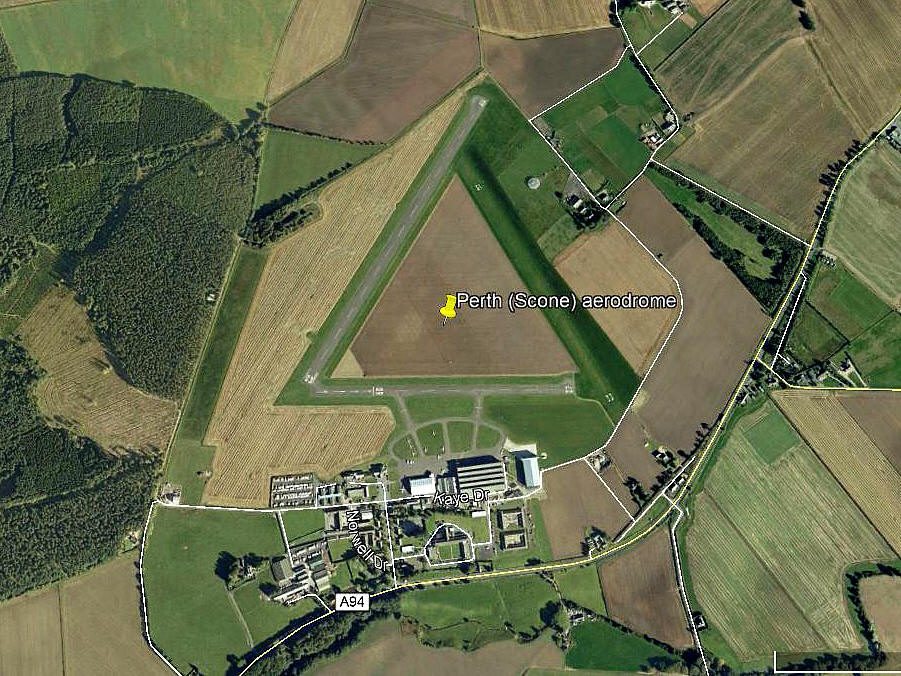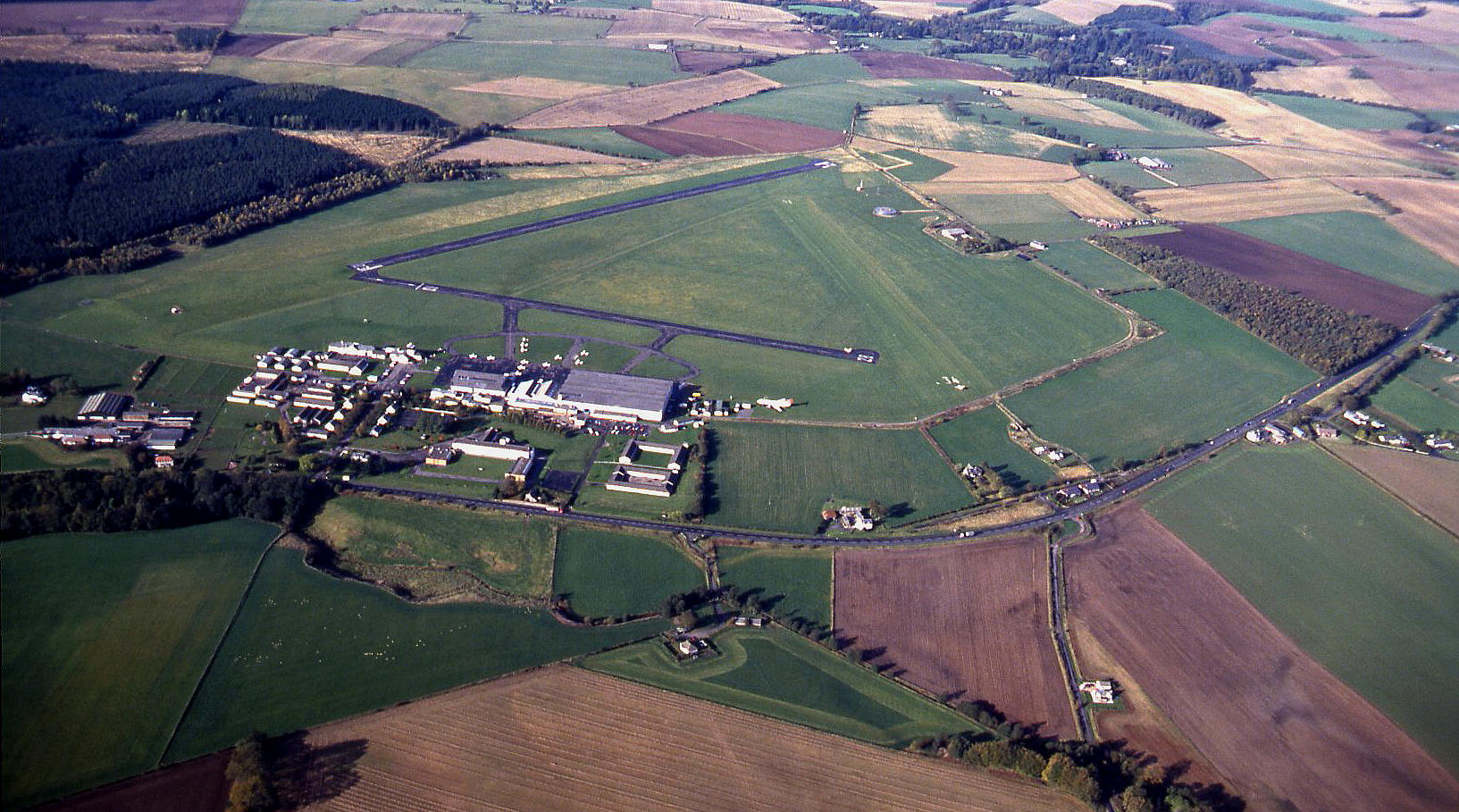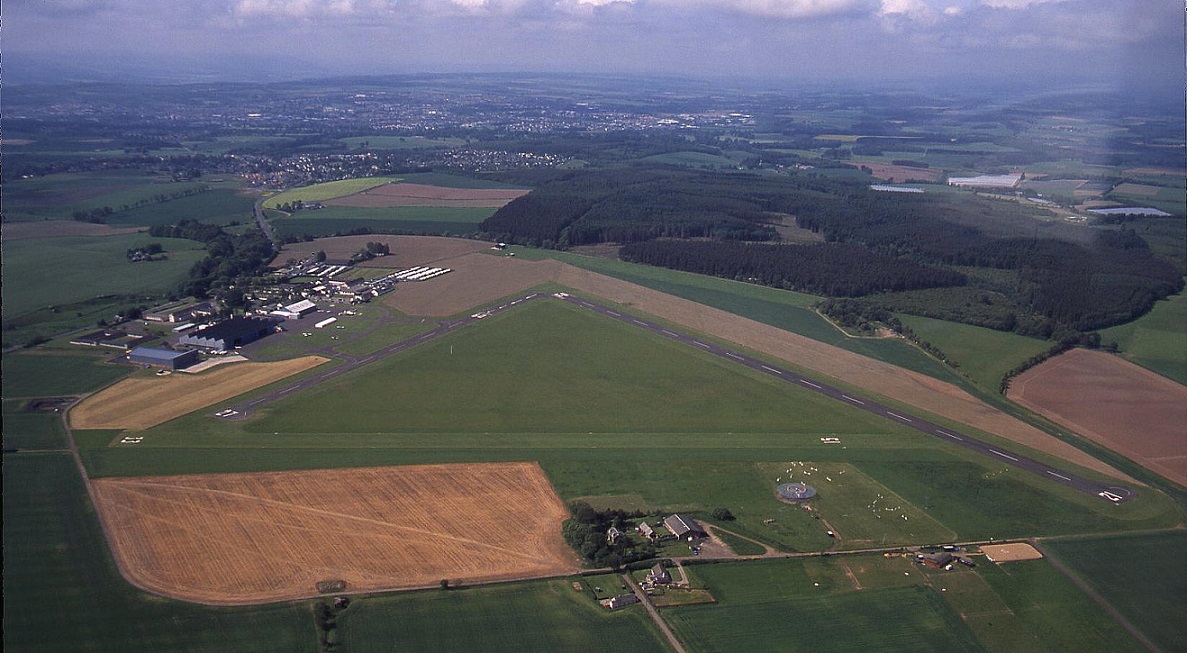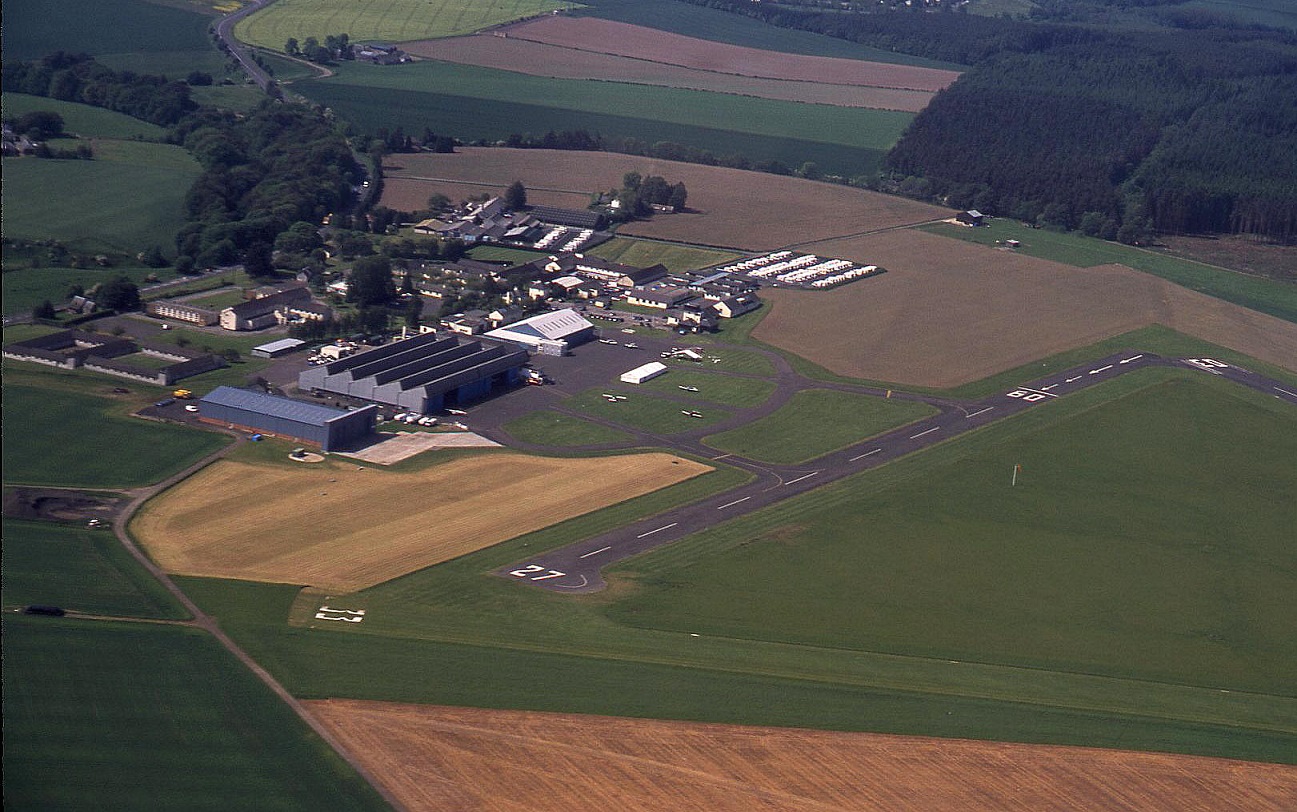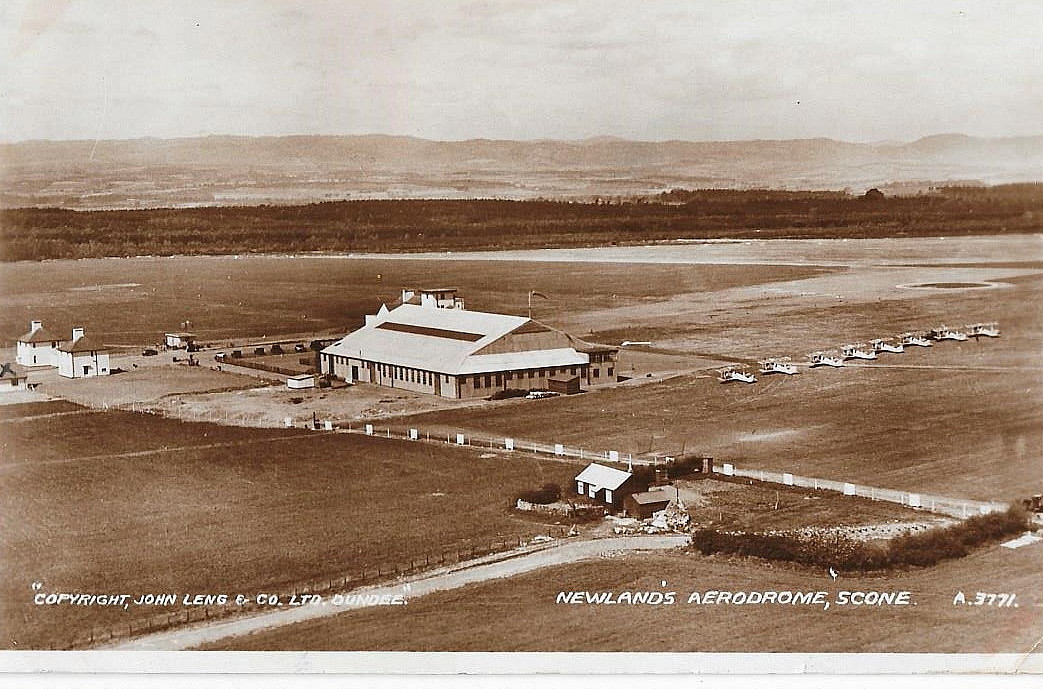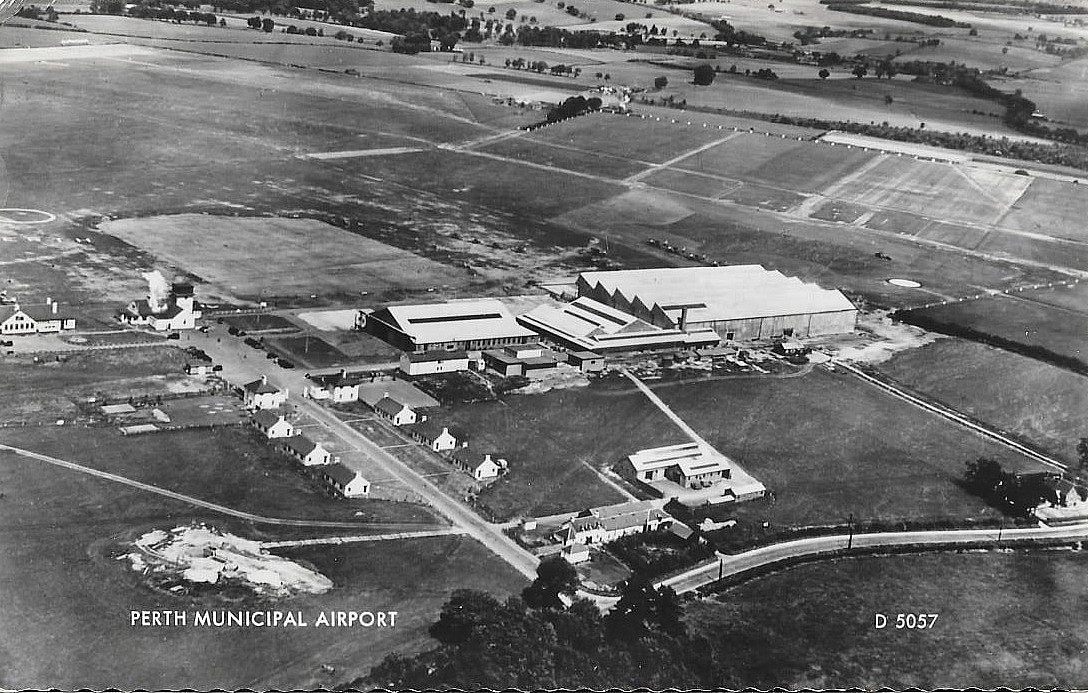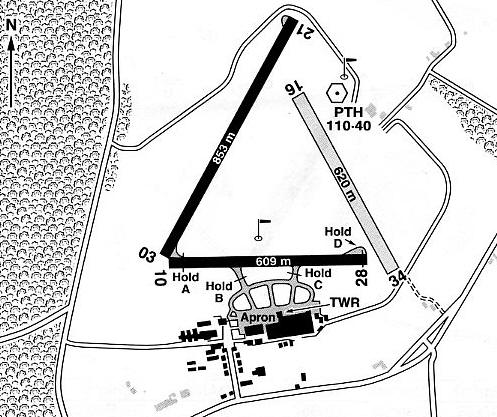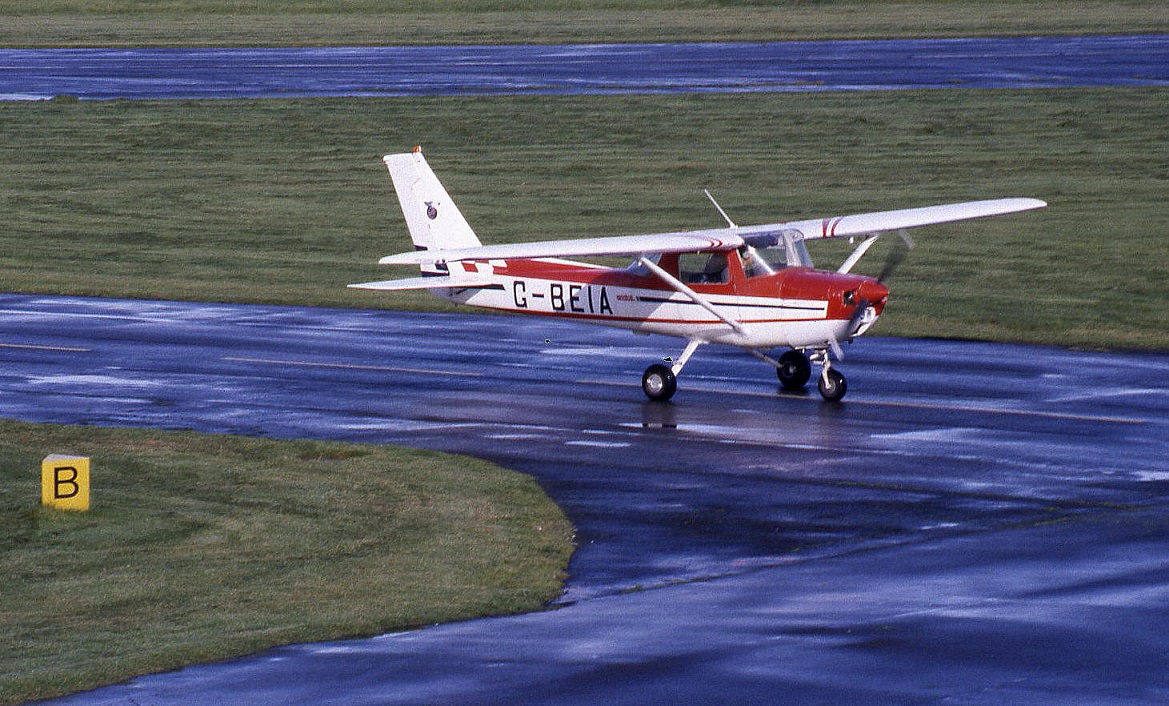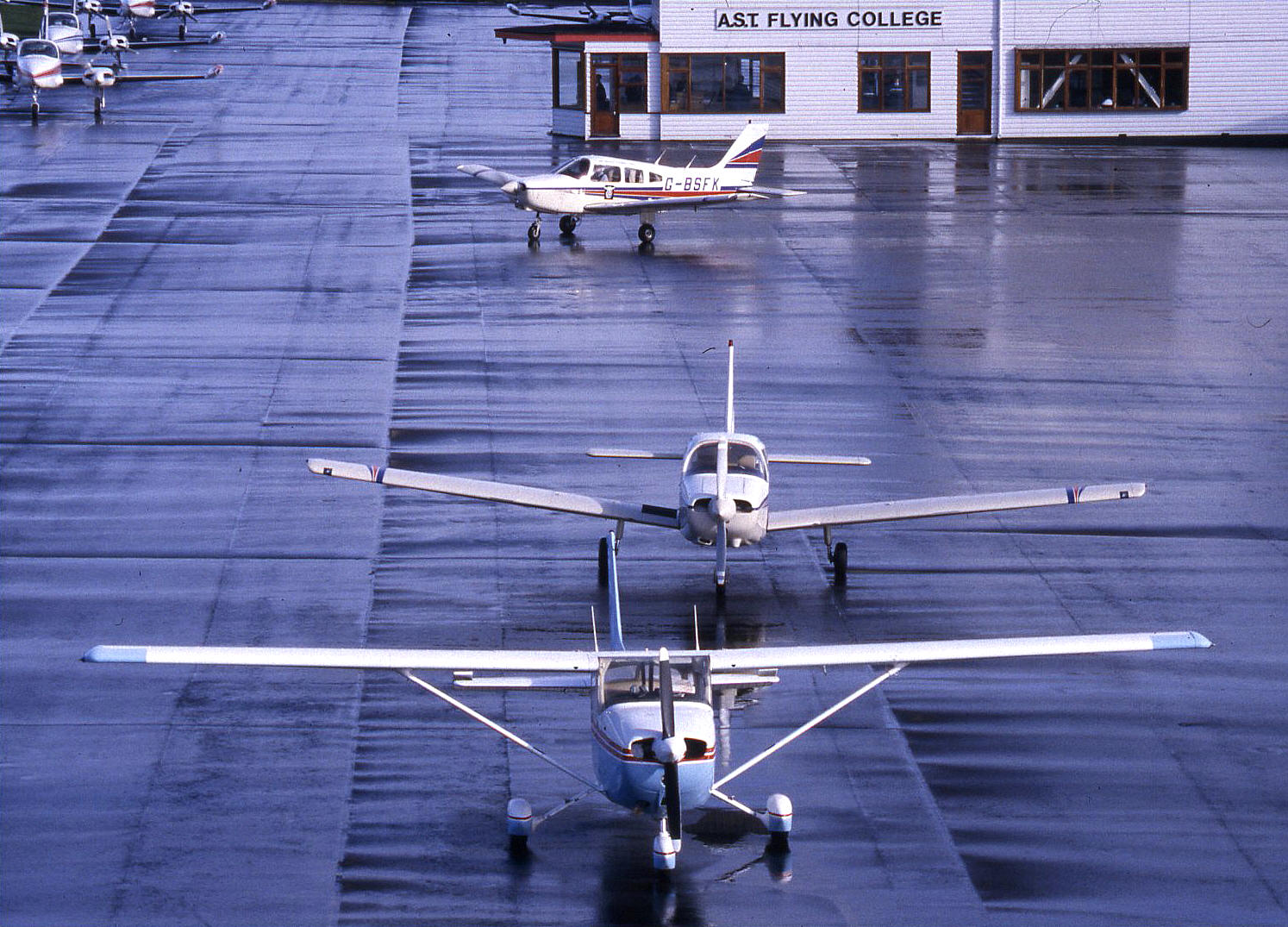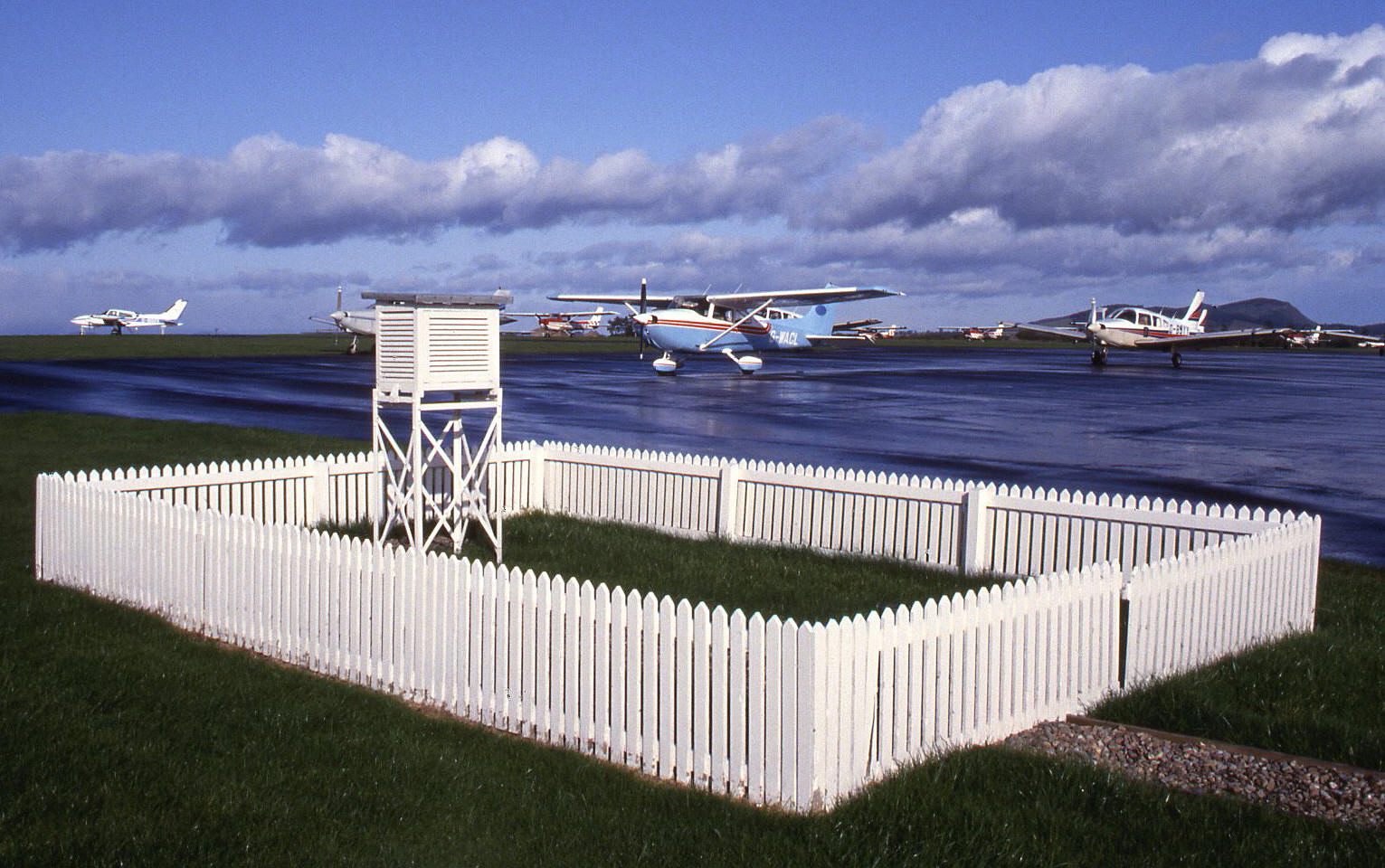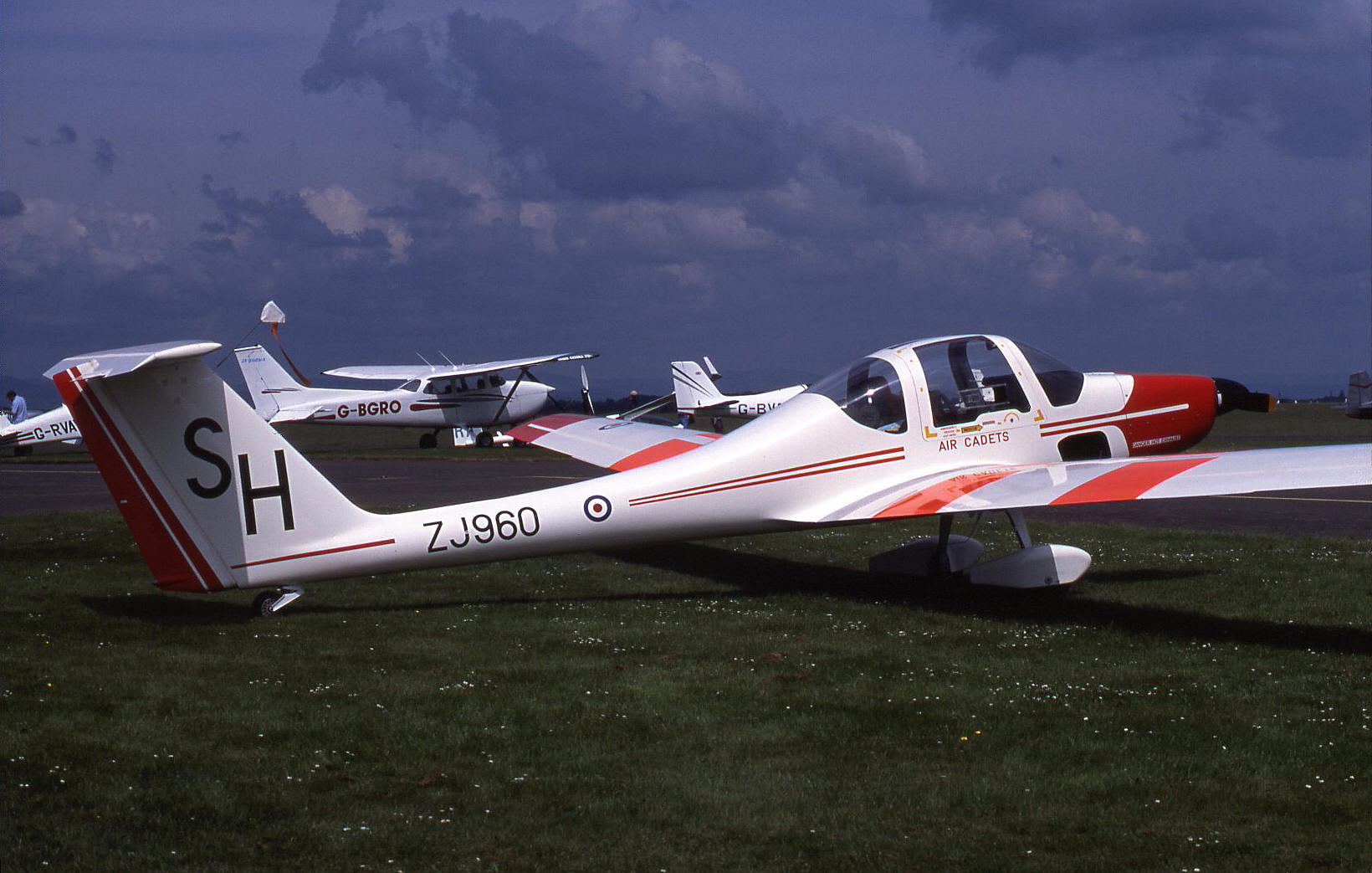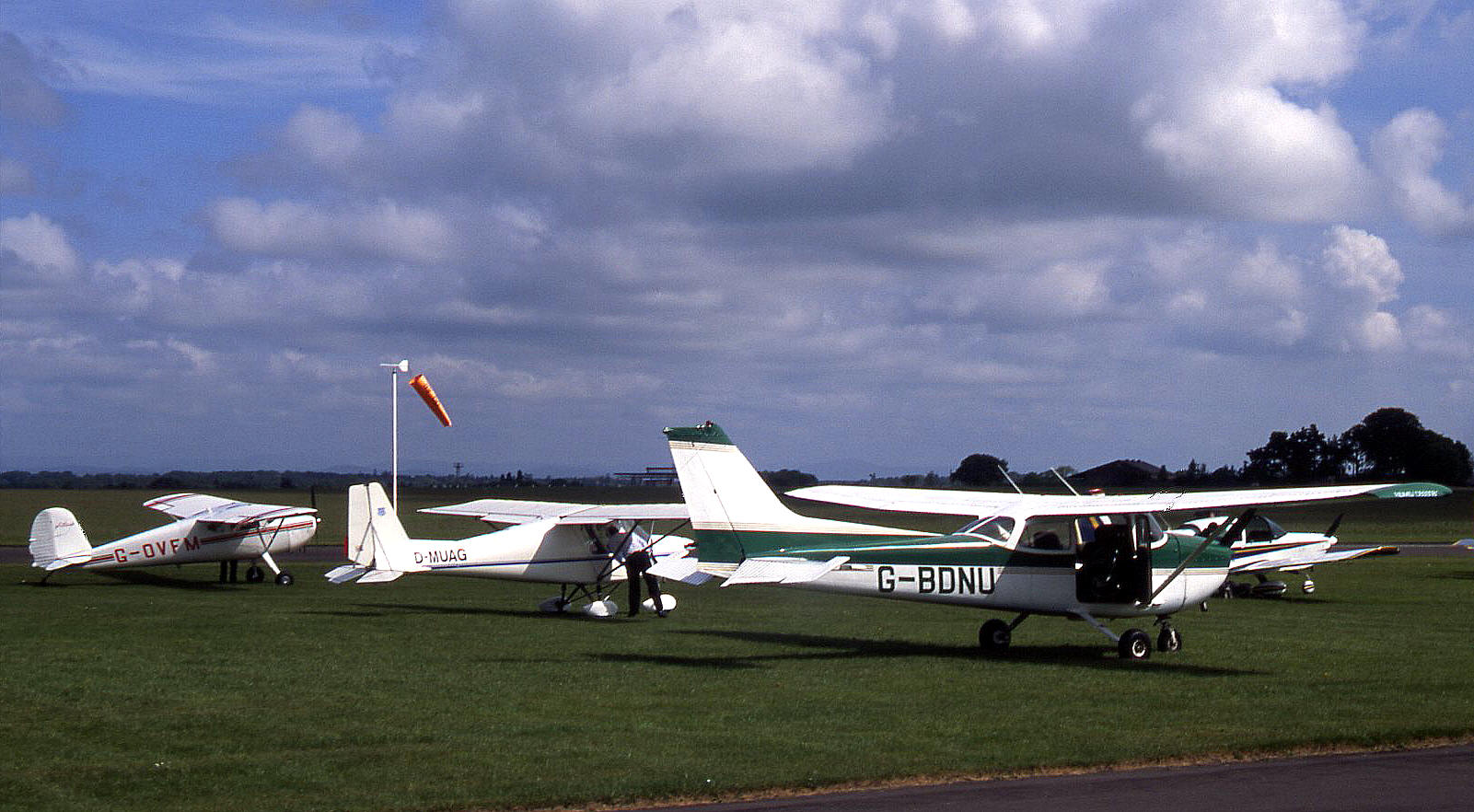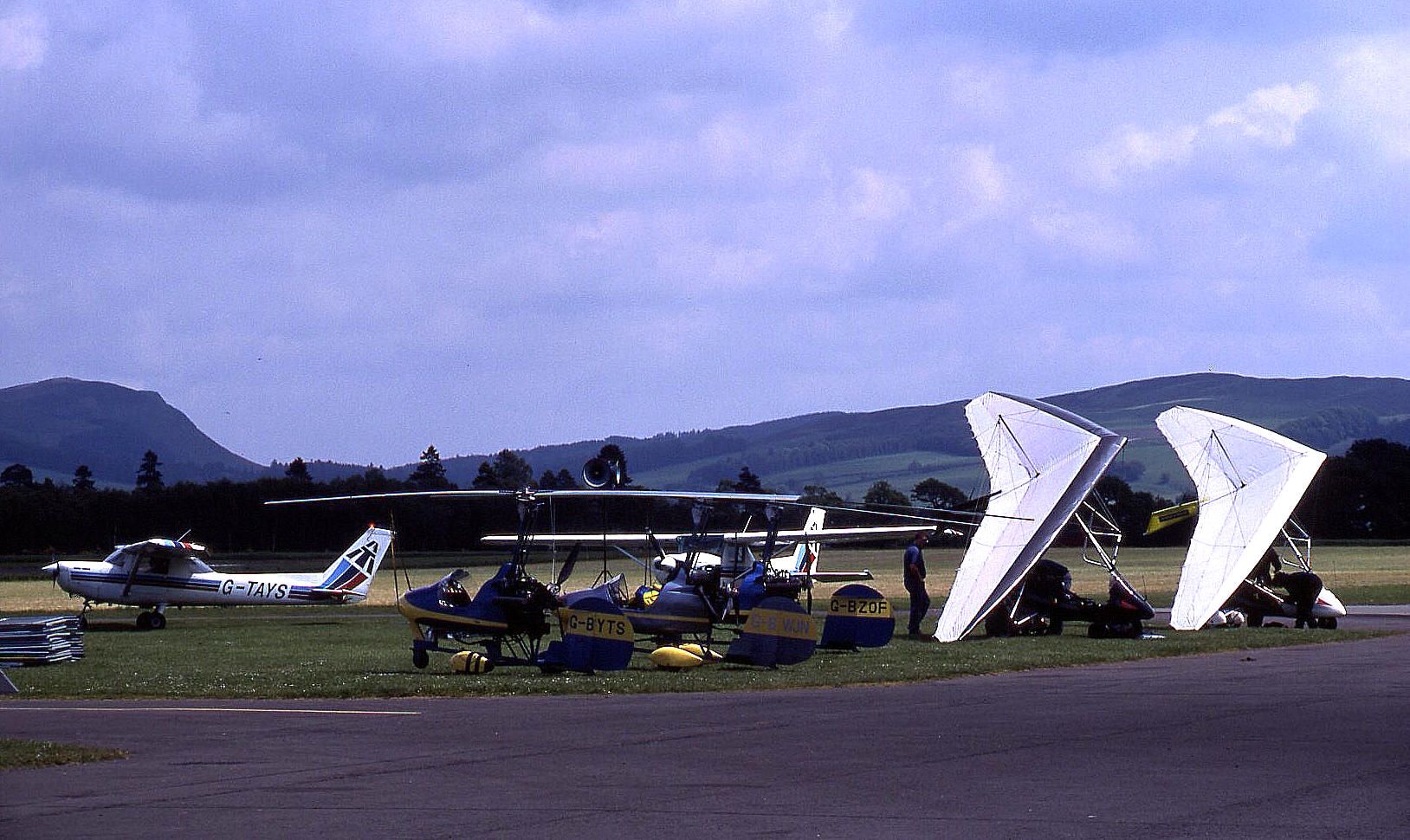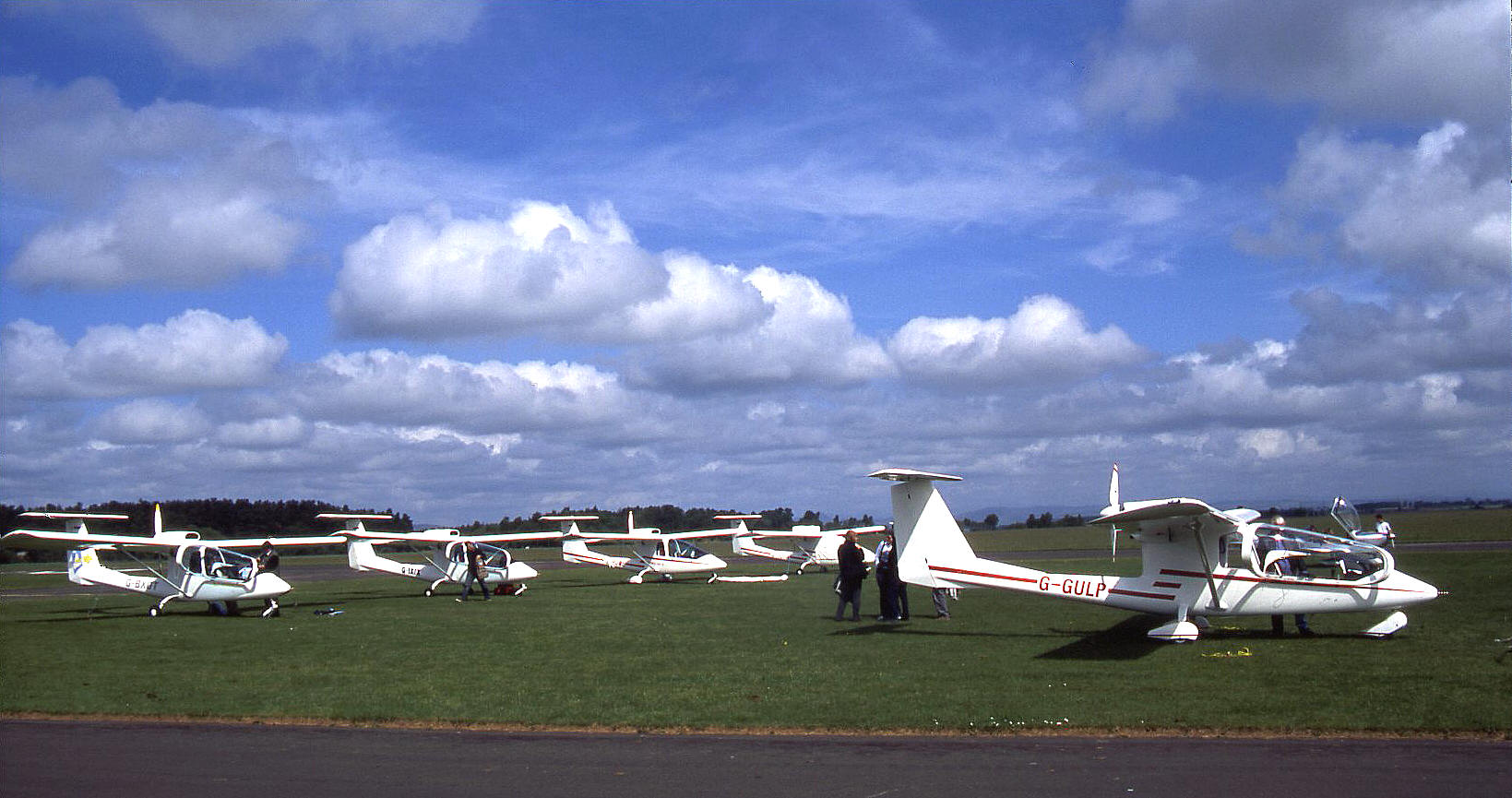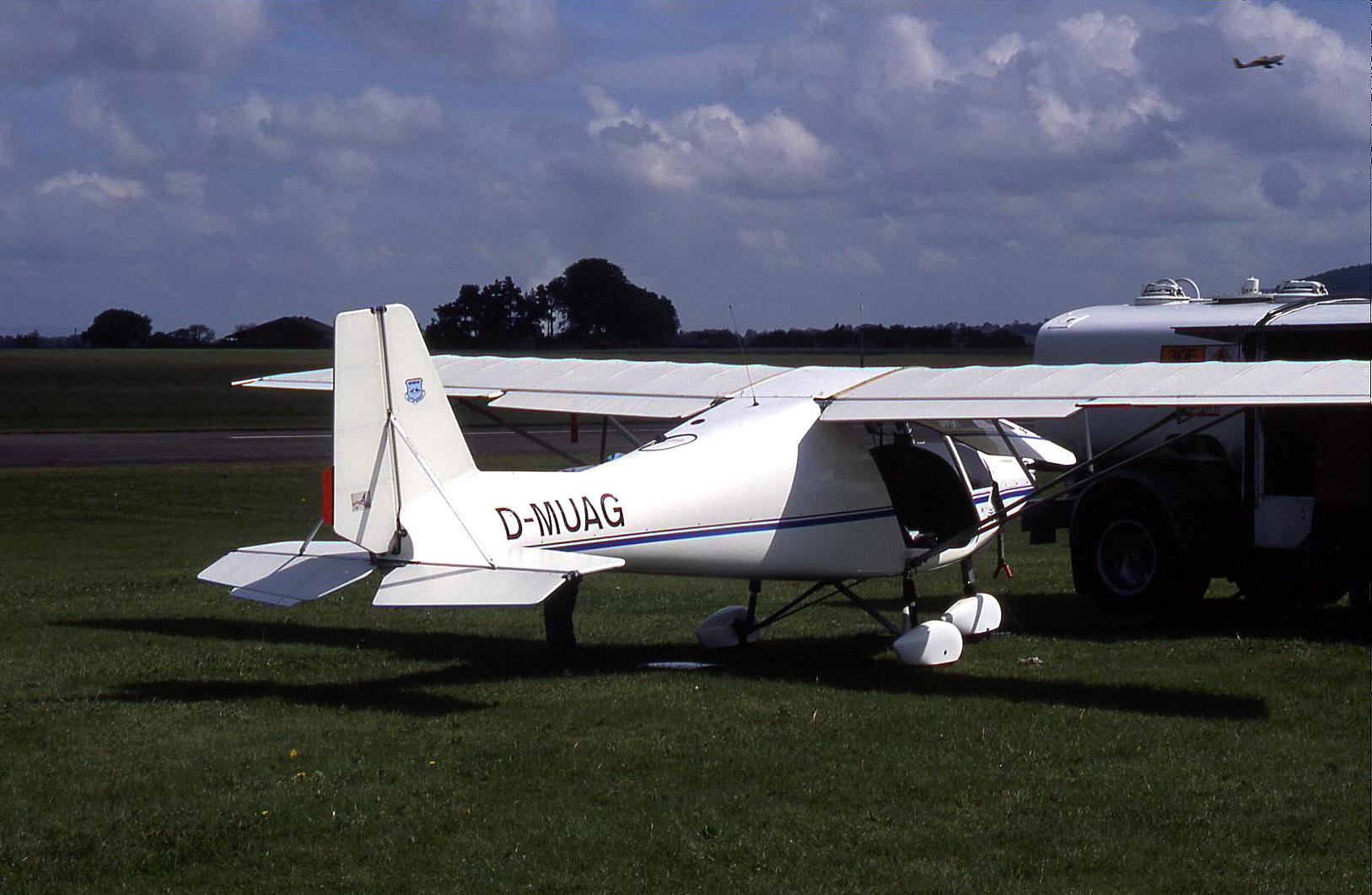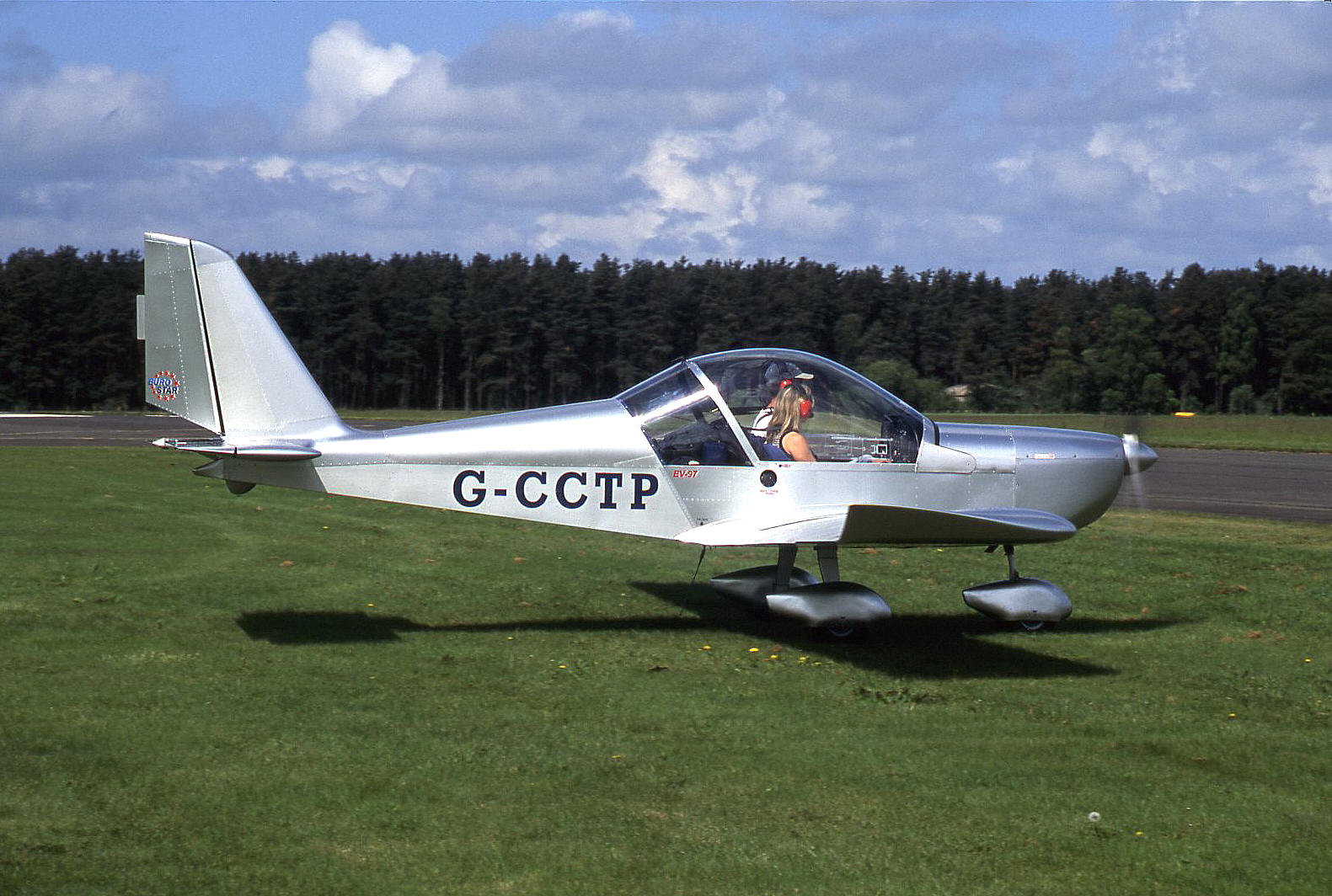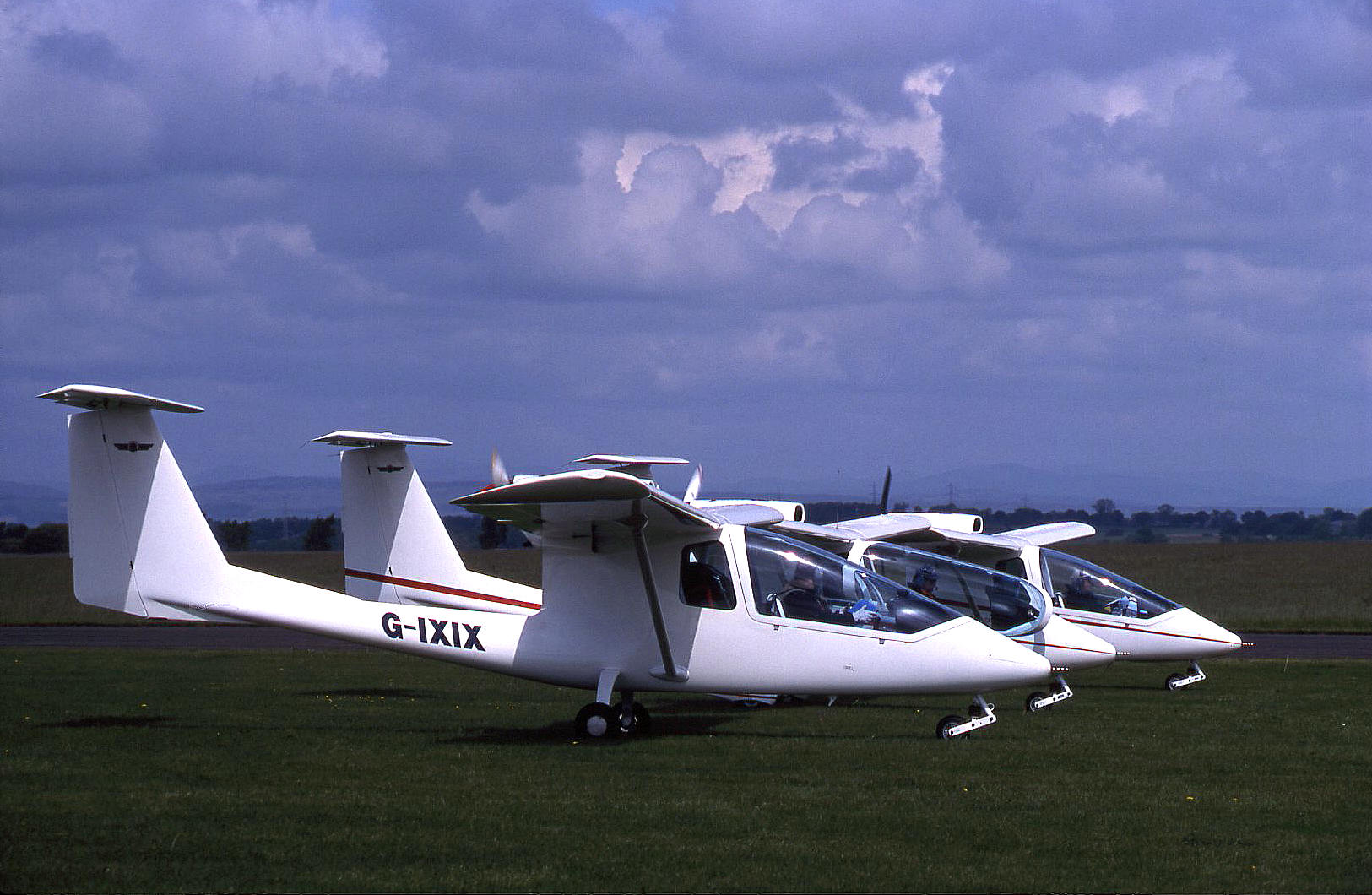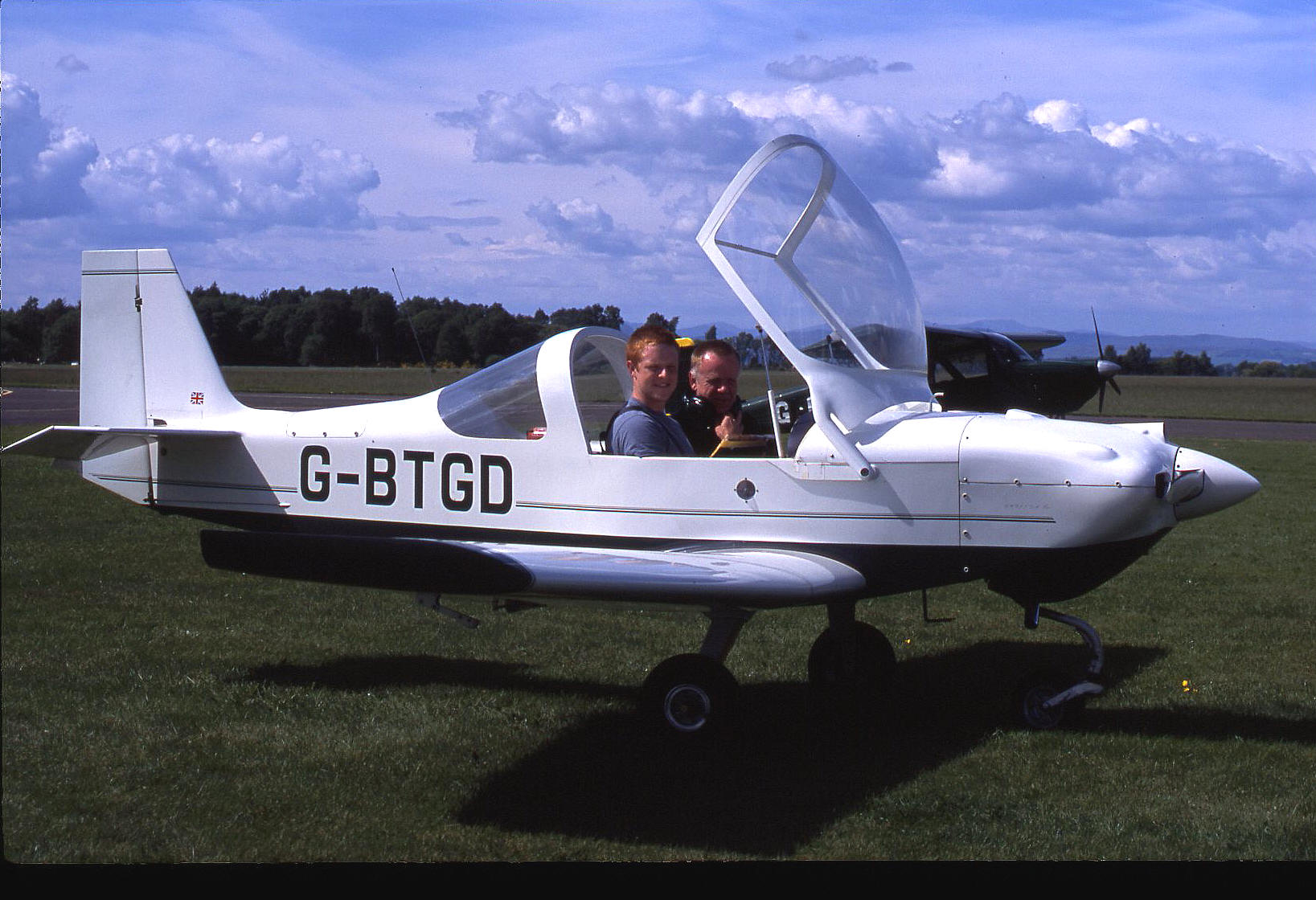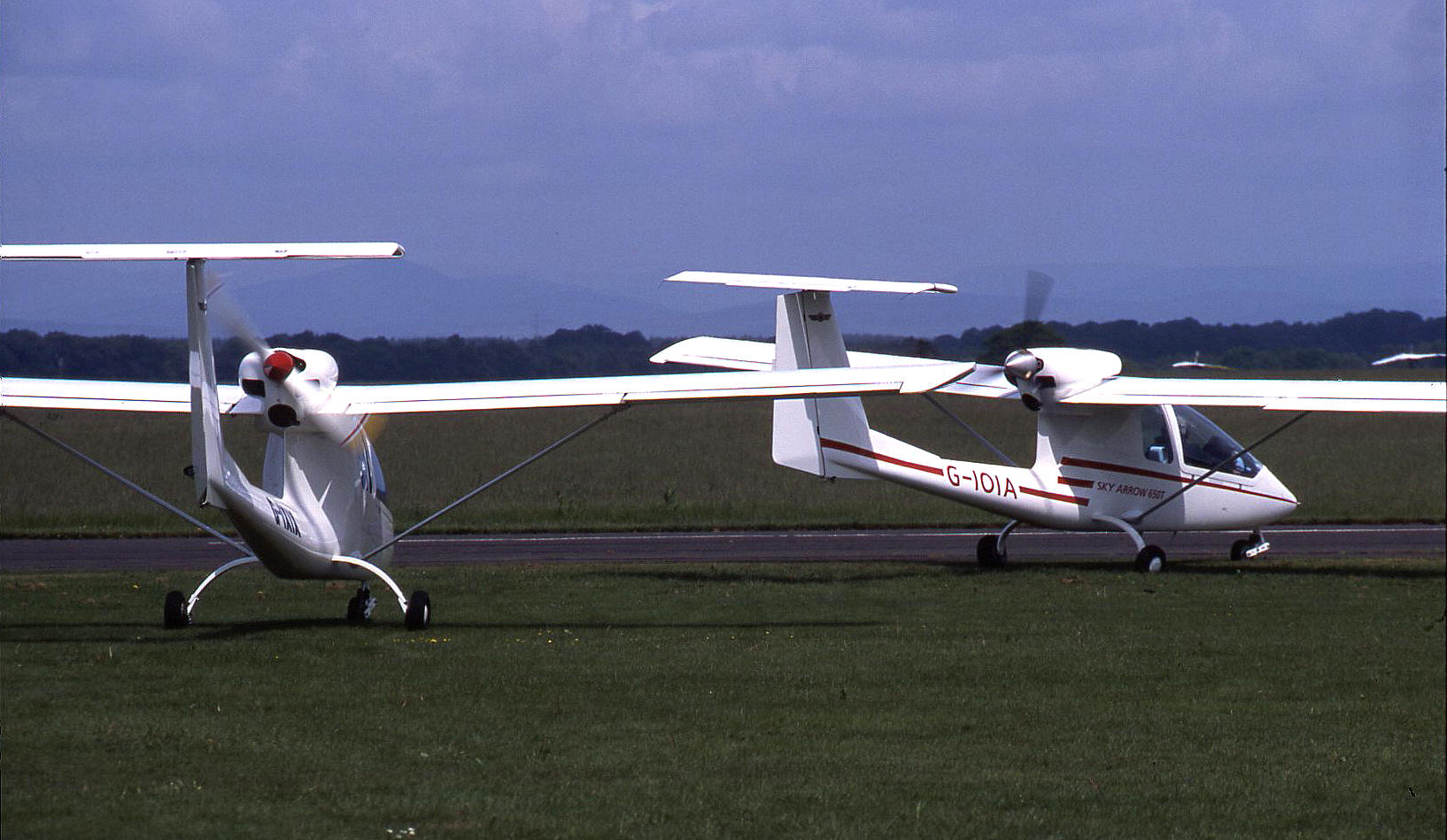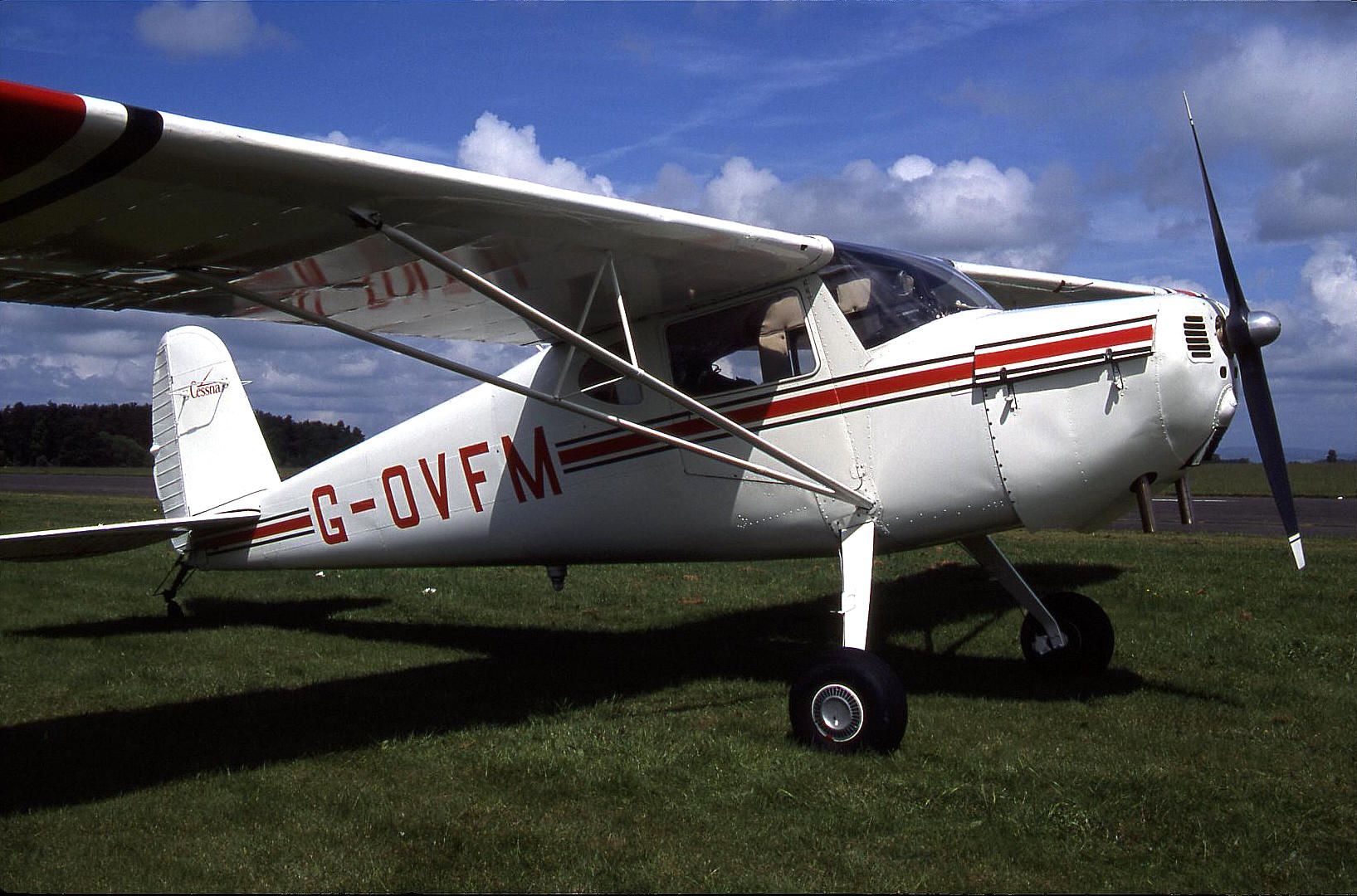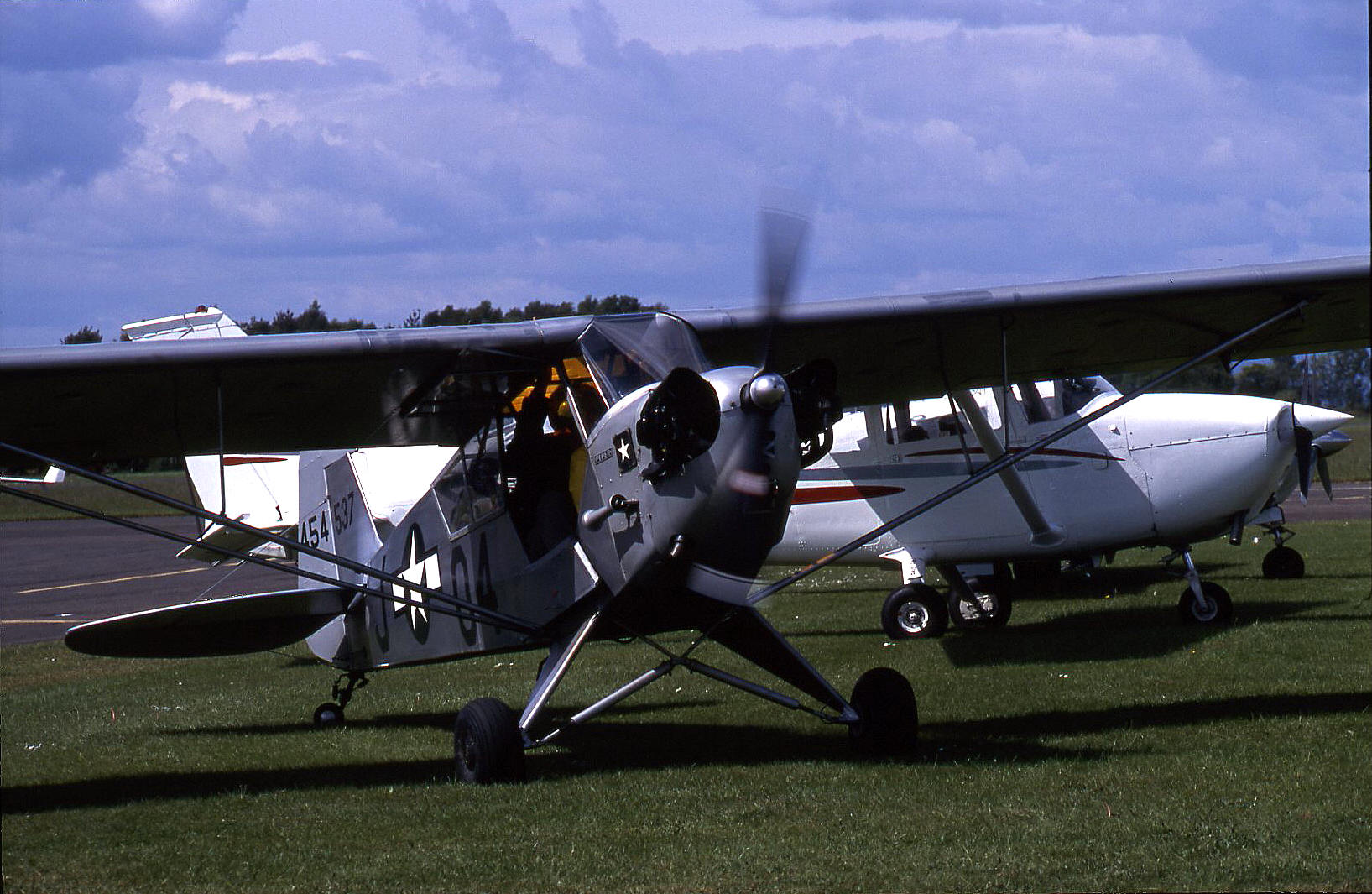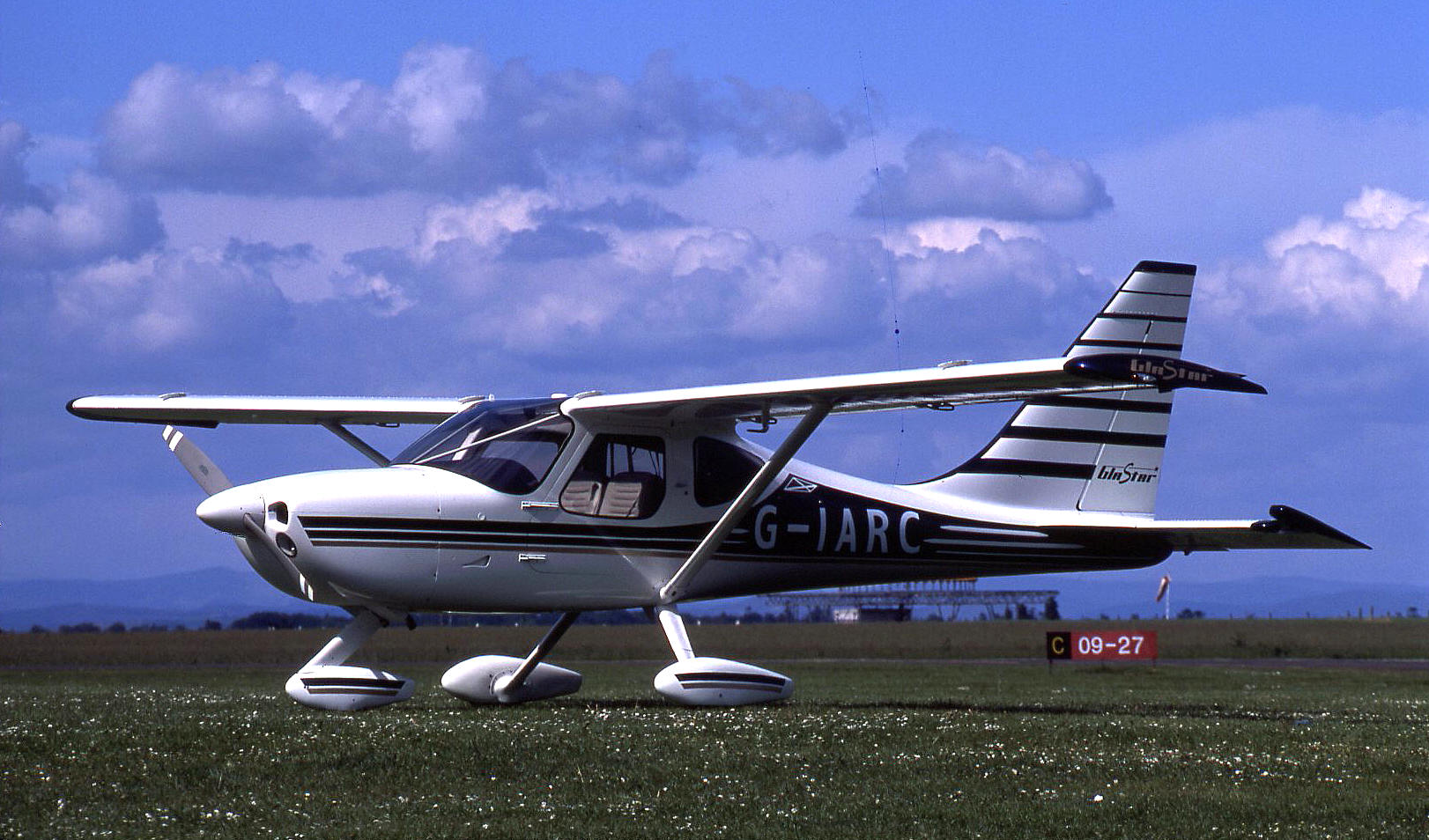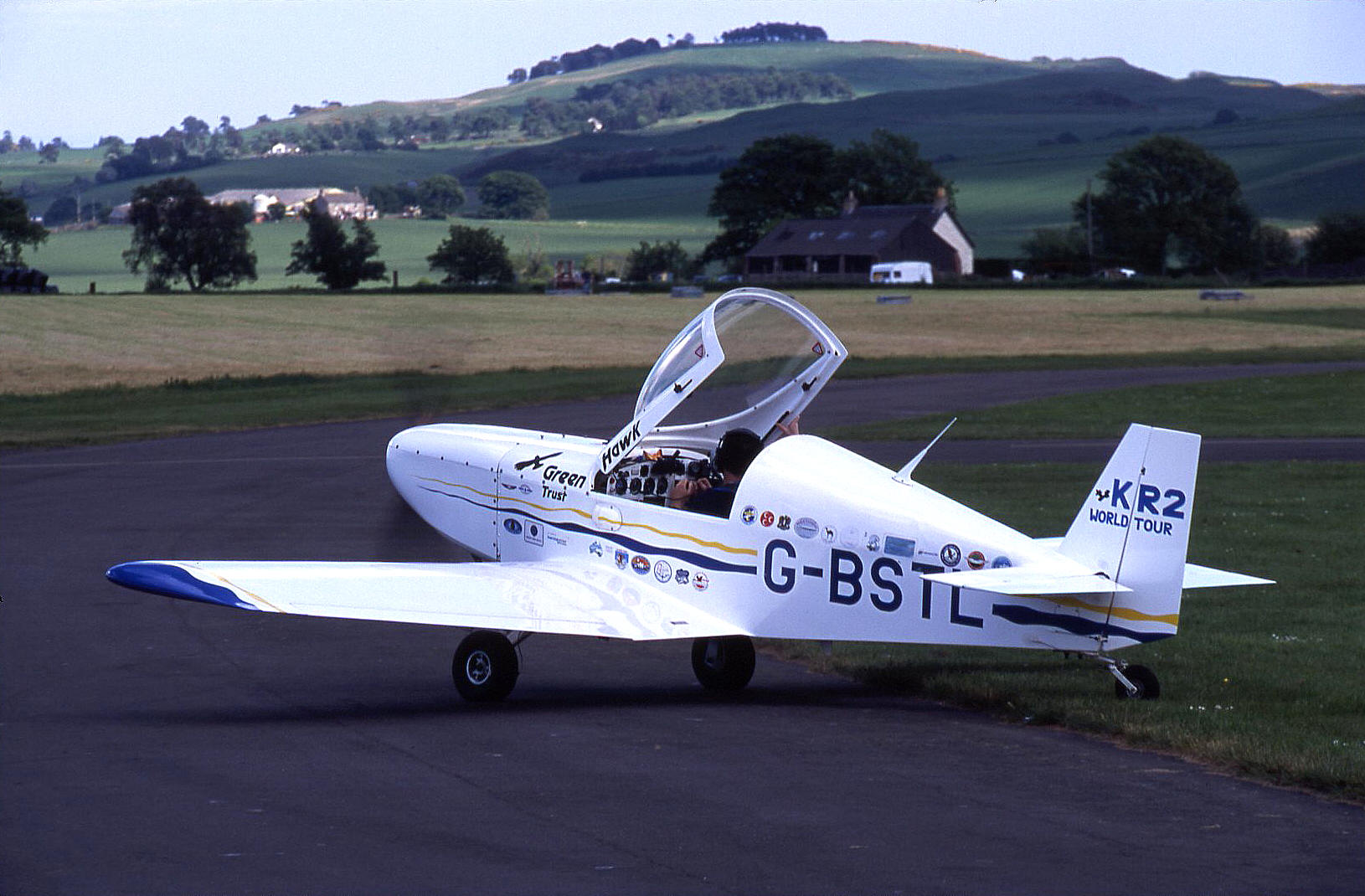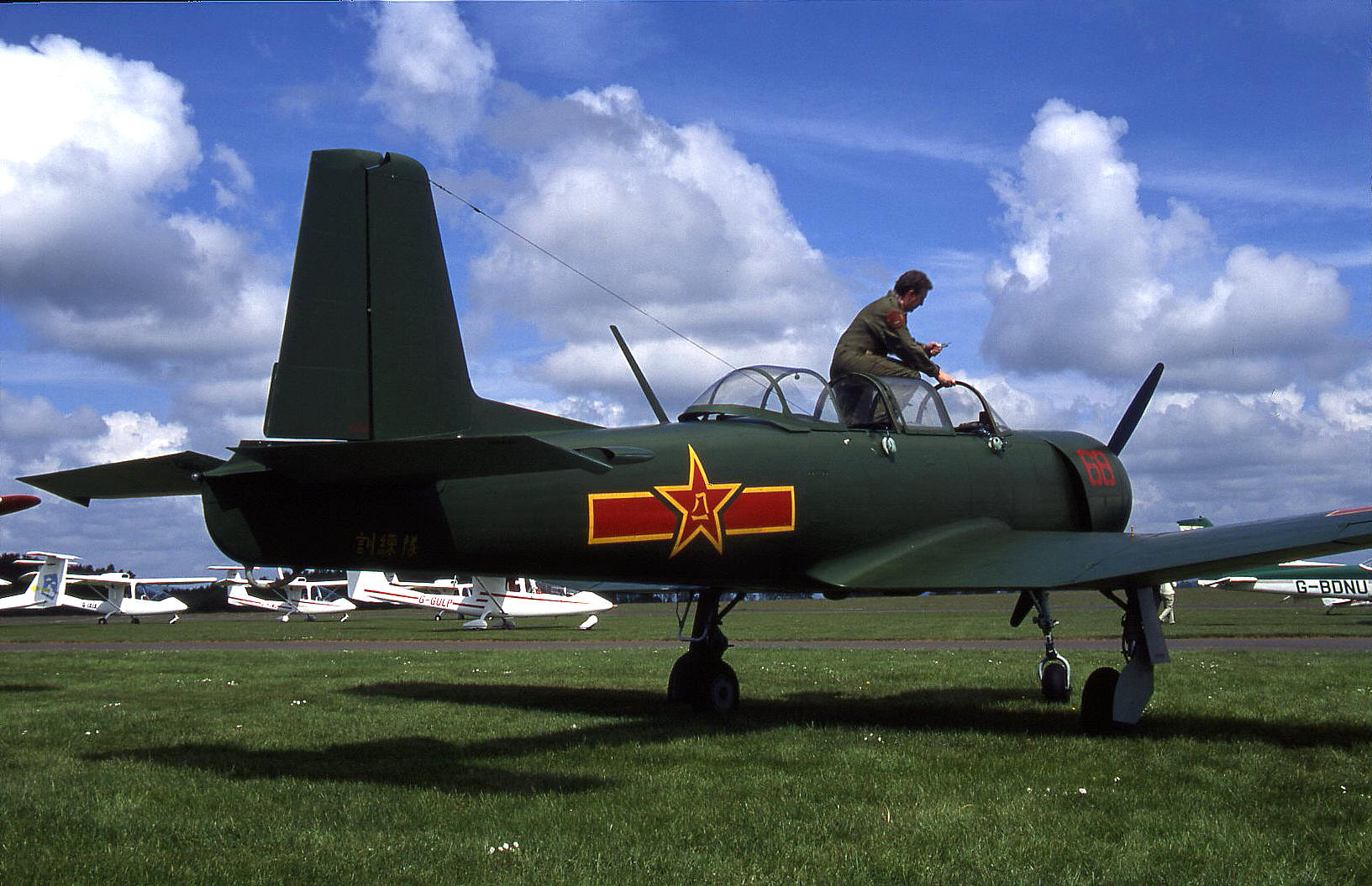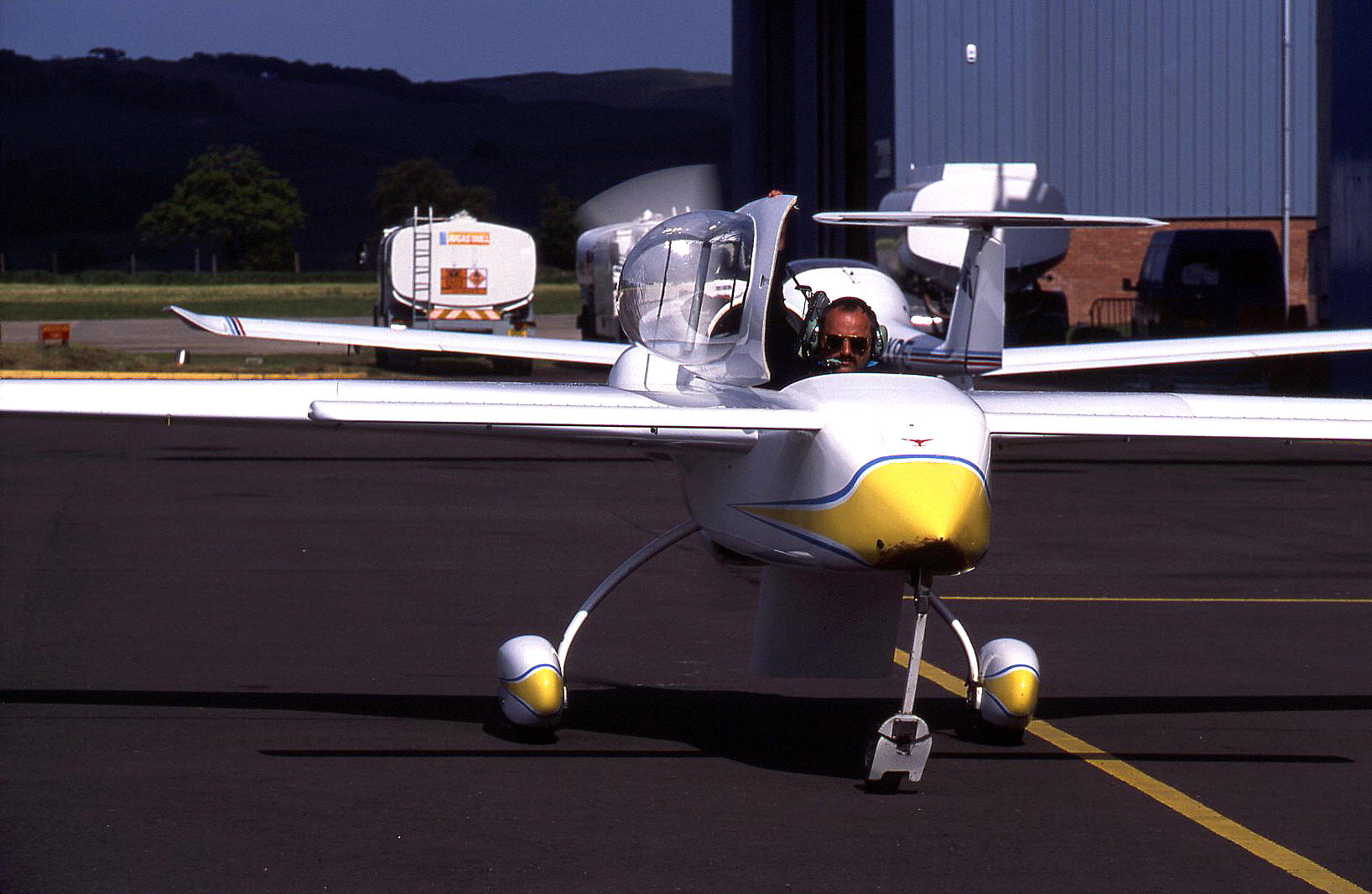Perth
PERTH see also WOODHEAD of MAILER
PERTH: Civil later military aerodrome (regional airport during 1930s) later civil again (Also known as SCONE)
Note: This picture obtained from Google Earth ©
Note: All other pictures by the author unless specified.
Military users: WW2: RAF Flying Training Command 51 Group
11 EFTS (DH82A Tiger Moths)
No.7 Air Observers and Navigators School ( Avro Ansons & Airspeed Oxfords) previously No.7 CANS
309 (Polish) Sqdn (Westland Lysanders)
No.6 Anti-Aircraft Co-operation Unit (Lysanders?)
No.5 Flying Instructors School (Tiger Moths & Miles Masters)
NOTES: Civil training centre for RAF pilots in the late1930’s.
No.11 Elementary and Reserve Flying School operated by Airwork (Avro Tutors, Fairey Battles and Hawker Harts) plus No.7 Civil Air Navigation School (Ansons & Oxfords)
Post WW2: AOP 666 Sqdn, No. 1966 AOP Flight (Auster AOP.6s)
Operated by: From 1936: Airwork
1965: Airwork Services Ltd
1980s/1990s: Air Service Training Ltd
From 1997: Tayside Aviation Ltd
2000: Perth Airport 2000
A major centre for basic airline pilot training during 60’s to present day (?) or at least until the 1990s?
British airline users: Pre 1940: North Eastern Airways and Scottish Airways (possibly also Railway Air Services and Highland Airways?)
WW2: British Airways (Lockheed 14s & Junkers Ju 52/3ms - Perth to Stavanger and/or Oslo service operated from 1939 to April 1940)
Post 1945: British European Airways
Note: These two pictures from postcards were kindly sent by Mike Charlton who has an amazing collection. See, www.aviationpostcard.co.uk
Flying club/schools: Pre 1940: Airwork (No.11 Reserve Flying School) and Strathtay Aero Club (Both from 1936)
Post 1945: Airwork (later Air Service Training pilot training and engineering school), Scottish Flying Club later Scottish Aero Club, Strathtay Aero Club, Tayflite (Tayflight?), Tayside Aviation/Scottish Aero Club
Note: In the 1957 The Aeroplane directory, the Scottish Aero Club fleet was given as:
Two Miles M38 Messengers, three DH82A Tiger Moths, one Auster and three Miles M14A Hawk Trainer 3s.
Maintenance: Post 1945: Airwork, MF Aviation, Tayflite (Engineering)
Location: N & W of A94, SW of Balbeggie village, 3nm NE of Perth
Period of operation: 1936 to -
Note: These maps are reproduced with the kind permission of Pooleys Flight Equipment Ltd. Copyright Robert Pooley 2014.
Runways: Details are sparse to say the least but as the original site grew it is recorded that two grass runways of 900 metres and another of 1300 metres were made available in the late 1930s. “Ample for the fastest modern airliners” it was claimed.
WW2: NE/SW 1189 grass
1965: 05/23 1173 grass 09/27 1113 grass
13/31 914 grass 18/36 945 grass
1968: 04/22 853x27 hard 10/28 609x22 hard
1990/2000: 03/21 853x27 hard 10/28 609x22 hard
16/34 620x36 grass
NOTES: Venue for Alan Cobham’s 1929 Municipal Aerodrome Campaign Tour visiting PERTH? As my knowledge of the history of PERTH/SCONE has increased I’d say this location was unlikely and perhaps another site needs to be sought in this area?
The first recorded landing at PERTH seems to be by the DH.85 Leopard Moth G-ACHD piloted by Mr W Gairdner on the 14th January 1936 although the ‘official’ opening ceremony took place on the 5th June 1936.
THE STRATHTAY AERO CLUB
It seems worth mentioning that when formed in 1936 the Strathtay Aero Club had just one aircraft, the Avro Avian G-AAHK which had been purchased from Mr Powrie, one of the Clubs founders. They had just one instructor too, Mr J S D Miles. Pretty soon though they acquired a B.A. Swallow 2 G-AEMW, a remarkable aeroplane that could take off, it is said, in 40 yards when flown solo, and 50 yards dual! With a cruise speed around 90mph I suppose we must wonder about many so-called “advances” in aircraft design since? It’s certainly worth comparing many more modern types with other enclosed cabin types of that era built for example by De Havilland, Miles and Percival. To illustrate at what price in terms of sacrificing overall performance in favour of comfort and ease of operation the mainly US built all-metal designs must pay.
In 1938 the Strathtay Aero Club achieved a ‘first’ in Scotland by appointing Miss Margaret Cunnison as their Chief Flying Instructor. Many women were flying in those days in the UK of course but to have women employed as instructors, let alone as a CFI was very rare if not unique. Still the case today of course and I’m proud to say our CFI in the Lion Flying Group at ELSTREE was for many years a lady pilot and a privilege to fly with.
NORTH EASTERN AIRWAYS
North Eastern Airways started operating from PERTH in 1936 using the Airspeed Envoy type later replaced with DH Dragon Rapides serving ABERDEEN, DONCASTER, EDINBURGH, INVERNESS, LEEDS, LONDON, NEWCASTLE and RENFREW. I have had to rely on what James Allan has to say in Wings Over Scotland relating to North Eastern Airways operations. It appears that EDINBURGH was a “request stop” and the company reserved the right to carry passengers on to PERTH and supply a rail ticket back to Edinburgh in the event of adverse weather. The reason being that unlike PERTH, EDINBURGH didn’t have wireless facilities so a safe approach and landing in adverse conditions couldn’t be made. Today of course, reliance on such primitive and unreliable single ‘wireless’ aids would be unthinkable, but fairly obviously in those days the way to go! But, those remarkable pilots kept up schedules by and large, often flying in very bad weather, and achieved a very good safety record.
WORLD WAR II
Towards the end of WW2 (P)AFU courses, (which stands for (Pilot) Advanced Flying Unit), were set up. These were designed to acquaint RAF pilots trained in Canada, Rhodesia, the USA etc with how to cope and understand the British weather and the very different navigation requirements needed when flying both in the UK and over Europe.
AFTER WORLD WAR II
After WW2 and roughly from 1947, and for many years afterwards, No.11 RFS operated by Airwork using Tiger Moths hosted summer camps with cadets coming from the University Air Squadrons of Aberdeen, Edinburgh, Glasgow, St Andrews and Queens University Belfast. From 1950 the Tiger Moths were gradually replaced by Chipmunks. A super-luxury type especially because of their enclosed cockpits during winter months! No.11 RFS was disbanded in June 1954.
BRITISH EUROPEAN AIRWAYS
In July 1950 BEA started a feeder service linking PERTH to RENFREW providing links across Europe and beyond. This service didn’t last long though and I wonder which type or types of aircraft BEA used?
AIR SERVICE TRAINING
PERTH is of course arguably best known for being associated with Airwork and later their Air Service Training off-shoot, the commercial pilot training school which operated here from 1955. Many airlines sponsored trainee pilots here, including a few that were certifiable idiots - invariably from Africa of course. This is not a comment that is in way racist as African people are just a capable as any race if given the same benefits . What was being reflected was the invariably utterly corrupt regimes, and the way they selected inappropriate candidates by way of favour to families, or tribes etc, having access to power. In this respect clearly nothing much has changed in Africa over the last sixty years and I suppose it is reasonable to suppose that Africa is mostly a hopeless case and will not improve for hundreds if not thousands of years.
The instructors in those days certainly earned their money attempting in vain, and often risking their lives, to try and train such hopeless candidates. During the 1950s Airwork were using mainly Tiger Moths, Miles Messengers and Chipmunks for single engine training and DH.89A Rapides and Airspeed Oxfords for twin engine instruction. In 1960 due to the huge success of the Airwork/AST commercial pilot training programme the entire fleet swopped over to being totally Cessna equipped, the C.150 being the single engine choice and the C.310 the twin type. In this ‘heyday’ period the Airwork fleet was claimed to be the largest fleet of Cessna aircraft operating in Europe.
During the 1960s and 70s around 120 to 150 student pilots were in training plus about 300 to 400 engineers. Students sponsored by all sorts of means ranging from self financing to scholarships provided by company or nationally arranged schemes came here from, for example; Algeria, Ghana, Greece, Hong Kong, Iraq, Kenya, Kuwait, Lebanon, Malaysia, Nigeria, Pakistan, Singapore, Sudan, Syria, Tanzania, Uganda and Zaire. It is claimed that citizens of over one hundred countries have been trained at PERTH and sometimes more than fifty different nationalities were present at one time. Even in 1990 this aerodrome was recording 17,000 movements a month! That amount of movements was only exceeded at HEATHROW some say. This said, it is claimed, roughly during the same period, WYCOMBE AIR PARK near to HEATHROW, exceeded in one year those recorded at HEATHROW.
OTHER ASPECTS OF AIRWORK
Quoting from Rowland White in his book Storm Front concerning the period up to 1972: “Little known back home, it sometimes seemed as if Airwork were responsible for keeping most of the world’s airlines and air forces in the sky. The company had helped establish airlines in Egypt, India and Rhodesia and supported air forces in Saudi Arabia, Abu Dhabi, Ghana, Qatar, Singapore, Nigeria, Sudan, Kuwait and Jordan, as well as taking part in the Berlin Airlift and running charter flights carrying pilgrims to and from Jeddah for the Haj.”
When the two hard runways were opened in 1968 PERTH became the first aerodrome with a flying school equipped with ‘all-weather’ hard runways and also during this period an ILS was installed, (later to be dismantled), plus a VOR which remains. I think it’s important to note that both the British Airways Trident and Air Inter Viscount were both flown into PERTH, presumably using the 853 metre long runway. Air Service Training ceased operating in 1996 and the future of the airfield looked very doubtful indeed.
THE SCOTTISH FLYING CLUB
It seems that in March 1956 the Scottish Flying Club based at RENFREW, having searched for many months to find a suitable base, agreed to amalgamate with the Strathtay Aero Club based here at PERTH/SCONE to form the Scottish Aero Club. The Scottish Flying Club Miles Magisters and a Messenger were flown across from RENFREW to reinforce the fleet.
It certainly seems worth quoting the Scottish Flying Club flying rates in 1956. On the Miles Messenger £4 dual and £3.15s solo and £3.15s dual or £2.15s solo on the other types like the DH.82A Tiger Moth. These figures appear as if from paradise today of course but are, when factored up, almost certainly equal if not more than most of us pay today. A photograph I have seen of the SFC fleet at PERTH in 1957 shows the Auster J.1 Autocrat (G-AGYL), two DH.82a Tiger Moths (G-AHUE & G-AHUV), one DH.87B Hornet Moth
(G-AJDF), two Miles M.14A Hawk Trainers (G-G-AJDR & G-AJDR) and two Miles M.38 Messengers, (G-AHZU & G-AJDF). Very typical of the time of course of so many UK flying clubs but - within the next decade or so the American GA invasion had arrived on our shores and in short order wiped out our indigenous light aircraft manufacturers.
AOP DUTIES
It seems that the RAF role of providing AOP duties, two units of which were once based at PERTH, was handed over to the Army Air Corps in or around September 1957, the date when this unit of Army aviation was first formed.
A LESSON TO BE LEARNED
On another tack many aerodromes and airports were something that for me as a youngster in the 1950s and 60s, felt and looked as if they had existed for at least a hundred years. This was mainly due to fact that there was no money going around for years and years after WW2 and as you get older it is soon realised that failures in upkeep of property pretty soon results in a nose-dive towards decrepitude. It was therefore a pretty rude shock o later discover that many of those ‘ancient’ aerodrome buildings and hangars I’d seen as a lad, were mainly barely more than twenty years old, and mostly of WW2 vintage.
A DIFFERENT APPROACH
At PERTH/SCONE it seems another approach was taken, quality being a major factor. The main contractors came from Glasgow it appears, and around 130 local tradesmen and 300 labourers from the district were employed and a very good job was done by all of them. The testimony to the quality of their work is shown today because nearly everything they built is not only standing today but still looks good. (Or did when I last visited in May 2004). There are many elements involved in constructing and operating aerodromes which I’ve since discovered, and this knowledge has added greatly to my understanding of what is actually required and just how complex the operation can be or is. Take for example the setting up of a new company called Grass Products (Perth) Ltd set up very soon after the aerodrome came into existence. They harrowed, rolled and fertilised the aerodrome to produce the thick mat of grass, “so necessary for a firm landing surface”, and they recycled the grass cuttings to be sold on as concentrated cattle feed!
TWENTY FIRST CENTURY NOTES
In 2006 I noticed the Scottish Aero Club had on offer for training what seems to me to be an unique combination of types, in the UK at least, encompassing fixed wing, rotary and flexwing microlight operations. Their ‘normal’ fleet aircraft consisted of two Cessna 152s, three Robinson R.22s, one Robinson R.44 and three Pegasus flex-wing microlights. This is remarkable enough but their fixed wing fleet contained four surprises for me at least. For example the Pitts S.2 was a hardly a common type in UK flight schools, but a few do have one - as did/does the Scottish Aero Club. Likewise they had a Socata TB.9 Tampico - was any other flying club operating one in the UK n 2006? I’m not a betting man but I’d put a fair few quid on the next two types being unique in the UK training sphere of operations? They advertised having a Beech 23 in the fleet but didn’t mention exactly which one. This range included the Musketeer, Sierra, Sport and Sundowner models. The big revelation, to me at least, was their having a Piper PA-22 Tri-Paceravailable! (the flying ‘milk-stool’ classic). I saw some of these PA-22 types being shoe-horned out of Pan-Am cargo DC-7Cs on the north side of HEATHROW in the early 1960s. To discover one, still available for flying training duties in 2006 was a delight - I just wish I lived nearer to PERTH to bash a few circuits in this example. I’ve flown a tail-dragger PA-22 Colt, and that certainly had a few lessons to be learnt about flying the type!
PERTH PICTURE GALLERY
On our joint books project for Ian Allan in 1992, we did divert a couple of times away fom our main subjects - UK airports. Perth was definitely a must, being so close to Dundee airport, as my friend and colleague Austin J Brown had gained a scholarship to attend Air Training Services in order to gain his ATPL (Airline Transport Pilots License) and he had very fond memories of his time spent here.
ANOTHER PERSONAL MEMORY
In May 2004, Linda Lavelle and I flew the Lion Flying Group Cessna FR172 G-BDNU from ELSTREE to the PFA Fly-In, calling in at various places on the way up, and on the way back. A trip not without challenges at various points due to bad weather, sea fog etc. The trip was made much easier as Linda had an IR (Instrument Rating).
On the way up we landed at SKEGNESS, BEVERLEY, FISHBURN (a weather diversion) and ERROL - because, being delayed we were refused permission to land at PERTH. On the way back we landed at PETERLEE and NORTH COATES. It seems to me that the many delights of flying north in the UK, especially if based in the south, are often overlooked - which really is a shame.
AND MORE PICTURES
*AN EXTRA NOTE
Departing in September 2001, Colin Hales and Nadine Brauns flew in G-BSTL to Australia. Most unusually the trip was without sponsorship and the stickers you can see on the fuselage were provided as a momento by people along the way. It really was a terrific achievement in so many ways, not least because this aircraft was by far the smallest to ever complete the voyage.
**NOTE: Regarding the last picture, not being an expert on Rutan types, I assume this is a Long EZ? I have tried to trace it, but failed. If anybody can kindly offer advice, this will be most welcome.
We'd love to hear from you, so please scroll down to leave a comment!
Leave a comment ...
Copyright (c) UK Airfield Guide















